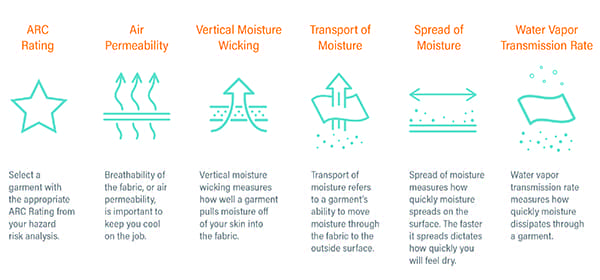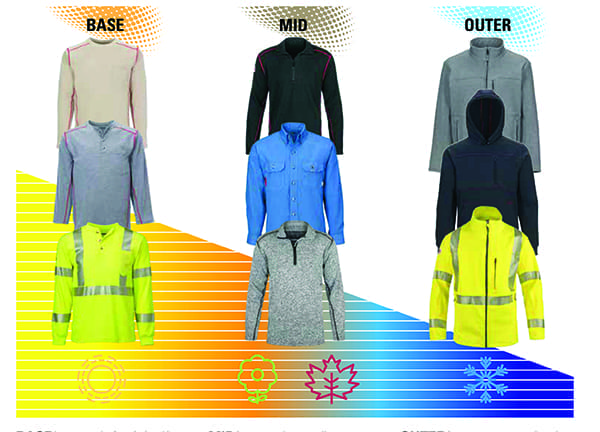Linemen Safety Best Practices and Apparel Selection
When a storm hits or the worst of weather conditions blow through, you’re there. The community of linemen is like no other because when the power goes out, you get to work. How do linemen remain prepared to handle some of the world’s most challenging workplace conditions? Staying informed of the current safety best practices and the valuable resources available to help you do your job is a great place to start. Grab your gaffs, grab your hooks, and read on.
Whether you’re interested in improving your performance on the line, expanding the safety knowledge of your team, or looking to modify your workwear for greater comfort and functionality, reviewing the considerations below is an essential step in optimizing your job site performance.
Best Practices for Improved Climbing Mechanics
Repetitive movements at work can mean that certain muscles you use each day are at risk for fatigue and overuse. A focus on training through building functional strength and endurance for your daily activities, while improving climbing mechanics, can help you improve efficiency and reduce injury.
Build Upper-Body Strength. Between hoisting rope, wire, and tools, and working overhead, your arms and shoulders get a daily workout. Push-ups require no machinery or weights, and they can be done virtually anywhere.
Focus on Your Core. Your core is your powerhouse and can help you in every job task. Core training will also help you improve climbing and balance on the pole. Planks are a great way to use your bodyweight to build strength.
Strengthen Legs by Mimicking Your Climb. If you want to climb with greater confidence and precision, build your leg and lower-back muscles. Practice climbing stairs to mimic the leg strength needed to push and pull yourself up the pole. Skip every other step to help build strength and agility.
Climb the High Side. Poles aren’t always straight. Always climb on the high side to keep your bodyweight above the pole. Position your body on an angle to maintain balance as you climb.
Secure Your Feet. Secure your feet before you advance upwards. If you have a tough area to get around, use your feet first, and trust your climbers. Once you’ve established a stable position, continue to climb.
Be Confident. Climbing doesn’t always come second nature. Gain confidence in your climbing ability with practice.
Best Practices for Improved Mental Concentration
Mental sharpness is one of the most important aspects on the line because it allows you to actively prevent accidents and stay safe. You look for dangers, you stay alert, and you work deliberately. Here are a few tips to boost concentration.
Get Enough Sleep. Your ability to stay focused on the job starts with a restful night’s sleep. Build a nighttime routine and stick to it to keep your mind sharp.
Stay Hydrated. Thirst is a distraction, and it usually means your body is already dehydrated. Drink regularly throughout the day to keep your mind and body engaged.
Exercise. Improve job performance by incorporating exercise into your weekly routine. Studies show that regular exercise helps boost chemicals that improve concentration, memory, and mental sharpness.
Comfort Matters. Your ability to concentrate depends a lot on your physical state. If your clothes are soaked with moisture or uncomfortable, your mind will not be 100% on the job.
Focus and Visualization Techniques. One task at a time, deliberate, calculated movements—on the ground that’s easy—50 feet in the air, that’s when focus is needed most. Practice visualization to help you improve focus and concentration.
Look for the Dangers. There are a number of distractions that can get you into trouble high in the air, such as squirrels, birds, or barking dogs. Be aware of your surroundings and focus your attention on the real dangers that can affect your safety.
Meditation and Breathing Techniques. Don’t overlook the power of meditation and simple breathing techniques to help you boost concentration. Deep breaths can do wonders for focus.
Rest and Stretch. Take a breather between jobs and stretch out sore muscles when your feet hit the ground. Giving your body a break and periodic stretching will help prepare you for the next stop on your route.
Tips for Keeping Your Body in Check
Regulating your body temperature is key to maintaining focus and preventing accidents. Choosing the right flame-resistant (FR) apparel and layering appropriately can be the difference between staying focused and putting yourself in harm’s way.
Prevent Heat-Related Illness and Injury. Heat stress occurs when body temperatures rise, and the body’s natural cooling mechanisms fail to cool the body down properly. It is a known occupational hazard for many industrial and utility workers, contributing to preventable work-related accidents and injuries. In fact, heat stress is one of the leading causes of accidents and injuries on the job.
When fighting heat and humidity, heatstroke can become a real concern for linemen who don’t wear protective apparel that wicks moisture effectively. The clothes you wear on the job can make a big difference in how you feel in your daily tasks. A garment that allows you to better control your body temperature means you can focus on the job at hand, and moisture-wicking plays an important role in thermoregulation.
Moisture-wicking technology is vital, because when moisture is left in a garment:
- ■ It blocks heat from escaping.
- ■ It leaves you more susceptible to heat illness.
- ■ Your body temperature rises quicker.
- ■ You become uncomfortable.
- ■ You have less focus on the task at hand.
An FR garment with moisture-wicking technology can help pull moisture off of your skin and through the fabric, where it will spread and dissipate from the outer surface.
How Moisture-Wicking Helps You Stay Cool in Hot Weather. FR clothing that uses a blend of wicking fibers is your best chance at staying cool in hot weather, but the key here is to look at your garment tag. You must ensure that the garment you select has permanent moisture-wicking capabilities, meaning it’s not just a “finish” that will wash out over time.
As you look at the tag, make sure it is a blend of hydrophobic and hydrophilic fibers (Figure 1), typically close to a 60/40 blend. This will show that the garment has permanent moisture-wicking capabilities.
 |
|
1. Hydrophobic fibers repel water while hydrophilic materials absorb it. A 60/40 blend of the two is optimal for moisture-wicking apparel. Courtesy: Lakeland Industries |
Select the Right Apparel. Choosing a flame-resistant/arc-rated (FR/AR) garment that lets you stay focused on the job is critical in an environment where every detail matters. Figure 2 shows some key apparel selection factors. How does your current FR performance apparel measure up?
 |
|
2. A number of qualities matter when selecting flame-resistant/arc-rated (FR/AR) apparel. Some to consider are the arc rating, air permeability, and moisture-wicking characteristics of garments. Courtesy: Lakeland Industries |
How to Layer FR/AR Apparel
Layering is the key to managing body temperature and improving performance on the line. However, understanding the do’s and don’ts of layering FR/AR apparel is not always as straightforward as it may seem. Consider the following recommendations when it comes to layering FR/AR clothing.
Don’t ‘Assume’ When Evaluating Arc-Flash Rating. Safety on the job starts with understanding how to appropriately evaluate your arc rating. Determining the required protection level is not as simple as adding A and B together. In many instances, the arc ratings may end up being higher than a simple A + B calculation. The increased arc thermal performance value (ATPV) is a result of the air space that is created between two layered garments, which acts as another insulator and layer of protection.
Don’t Select Cotton or Synthetic Materials for Your Base Layer. Instead of choosing your favorite cotton or performance tech t-shirt, opt for a moisture-wicking garment. Why? An FR garment with permanent moisture-wicking technology helps keep you feeling cool.
Do Select a Layering System with Moisture-Wicking Technology. As you add layers, make sure each additional garment adds moisture-wicking capabilities so sweat will be pulled away from your skin through the fabrics, layer by layer, to dissipate on the outer surface.
Do Think About the Versatility of Dual-Certified Layers. By encouraging your team to wear an FR/AR layering system from base layer to outer layer, you can help ensure they are protected even when they move through various duties with different hazard ratings.
Selecting High-Performance FR/AR Apparel
An FR/AR apparel layering system (Figure 3) is designed specifically to work together, layer by layer, to keep you dry and cool/warm. Base layers are the foundational key to help you stay dry and cool during the warm months and warm during the cool months. Mid-layers are versatile garments that can help take the chill off when the sun is just coming up in the morning, or setting at night. Outer layer garments complete the system, giving you the comfort and protection needed, with wind and water resistance to help keep the elements at bay.
 |
|
3. Lakeland’s new high-performance FR/AR apparel layering system offers features that help you not only manage body temperature but also incorporate critical safety attributes. Courtesy: Lakeland Industries |
To get the best performance from FR/AR apparel, remember the following:
- ■ The optimal blend of hydrophobic and hydrophilic fibers is a 60/40 fiber split. This offers superior moisture wicking and drying characteristics.
- ■ Outerwear garments offer both water and wind resistance, so you can feel confident in your apparel, even if the weather changes quickly.
- ■ A balance of protection and fabric quality, with extra design details like seamless underarm gussets, flat seam construction, and a relaxing athletic cut are important for safety and comfort. ■
—Brad Sipe is director of business development with Lakeland Industries (www.lakeland.com).